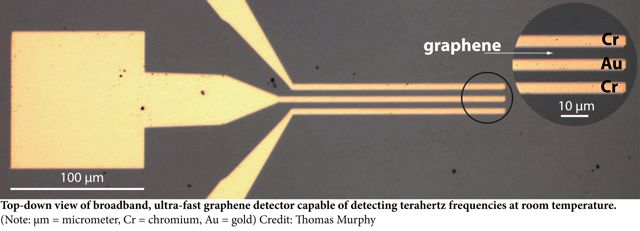September 17, 2014
COLLEGE PARK, Md. - New research at the University of Maryland could lead to a generation of light detectors that can see below the surface of bodies, walls, and other objects.
Using the special properties of graphene, a two-dimensional form of carbon that is only one atom thick, a prototype detector is able to see an extraordinarily broad band of wavelengths. Included in this range is a band of light wavelengths that have exciting potential applications but are notoriously difficult to detect: terahertz waves, which are invisible to the human eye.
A research paper about the new detector was published in Nature Nanotechnology. Lead author Xinghan Cai, a University of Maryland physics graduate student, said a detector like the researchers' prototype "could find applications in emerging terahertz fields such as mobile communications, medical imaging, chemical sensing, night vision, and security."
The light we see illuminating everyday objects is actually only a very narrow band of wavelengths and frequencies. Terahertz light waves' long wavelengths and low frequencies fall between microwaves and infrared waves. The light in these terahertz wavelengths can pass through materials that we normally think of as opaque, such as skin, plastics, clothing, and cardboard. It can also be used to identify chemical signatures that are emitted only in the terahertz range.
Few technological applications for terahertz detection are currently realized, however, in part because it is difficult to detect light waves in this range. In order to maintain sensitivity, most detectors need to be kept extremely cold, around 4 degrees Kelvin, or -452 degrees Fahrenheit. Existing detectors that work at room temperature are bulky, slow, and prohibitively expensive.
The new room temperature detector, developed by the University of Maryland team and colleagues at the U.S. Naval Research Lab and Monash University, Australia, gets around these problems by using graphene, a single layer of interconnected carbon atoms. By utilizing the special properties of graphene, the research team has been able to increase the speed and maintain the sensitivity of room temperature wave detection in the terahertz range.
Using a new operating principle called the "hot-electron photothermoelectric effect," the research team created a device that is "as sensitive as any existing room temperature detector in the terahertz range and more than a million times faster," says Michael Fuhrer, professor of physics at the University of Maryland and Monash University, Australia.
Graphene, a sheet of pure carbon only one atom thick, is uniquely suited to use in a terahertz detector because when light is absorbed by the electrons suspended in the honeycomb lattice of the graphene, they do not lose their heat to the lattice but instead retain that energy.
The concept behind the detector is simple, says University of Maryland Physics Professor Dennis Drew. "Light is absorbed by the electrons in graphene, which heat up but don't lose their energy easily. So they remain hot while the carbon atomic lattice remains cold." These heated electrons escape the graphene through electrical leads, much like steam escaping a tea kettle. The prototype uses two electrical leads made of different metals, which conduct electrons at different rates. Because of this conductivity difference, more electrons will escape through one than the other, producing an electrical signal.
This electrical signal detects the presence of terahertz waves beneath the surface of materials that appear opaque to the human eye – or even x-rays. You cannot see through your skin, for example, and an x-ray goes right through the skin to the bone, missing the layers just beneath the skin's surface entirely. Terahertz waves see the in-between. The speed and sensitivity of the room temperature detector presented in this research opens the door to future discoveries in this in-between zone.















